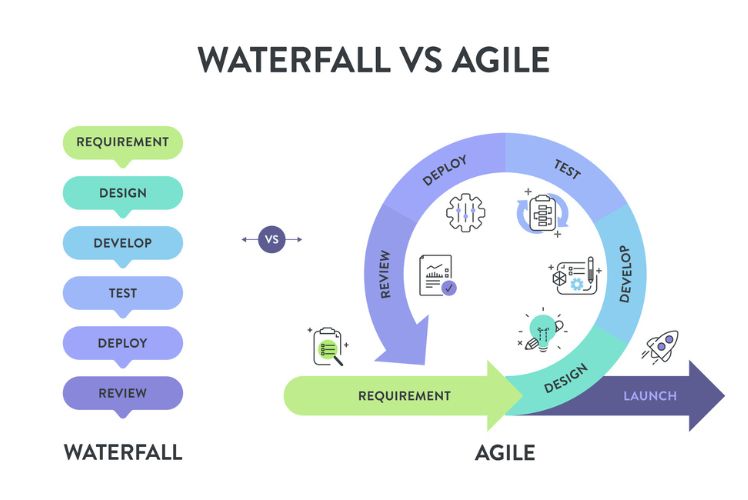When managing projects, we often hear about the debate between Agile and Waterfall methods. The main difference is that Agile is flexible and encourages changes throughout the process, while Waterfall follows a strict, step-by-step flow from start to finish. Understanding which approach fits our project needs can make our work much smoother and more successful.

If we need a method that allows for quick changes and ongoing feedback, Agile might be the better choice. On the other hand, if our project has clear requirements from the beginning and we prefer a more predictable path, Waterfall may work well. Both have their own strengths and limitations, and choosing the right one can make a big impact on results.
Key Takeaways
- Agile is flexible and adapts to changes, while Waterfall is linear and structured.
- Each approach has unique practices suited to different project types.
- Picking the right method depends on our project goals and requirements.
Fundamental Concepts of Agile and Waterfall

Both agile and waterfall are widely used project management methodologies in software development and other industries. They offer different approaches to planning, execution, and delivery, shaping how teams organise work and manage change.
Overview of Agile Methodology
Agile methodology is an iterative and incremental approach to project management. We focus on breaking projects into small, manageable units called “sprints” or “iterations”, which usually last a few weeks. Each sprint aims to deliver a usable product increment.
Communication and teamwork are central to agile. We adapt our plans as requirements change, with constant feedback from customers or stakeholders guiding development. This flexibility helps our teams respond quickly to shifting needs or new insights.
Agile promotes working software over detailed documentation. Rather than complete everything at once, we prioritise tasks and adjust work based on outcomes. Teams meet regularly, often daily, to discuss progress, remove roadblocks, and decide on immediate next steps.
Time, cost, and resources are set, but scope evolves as the project progresses. This dynamic approach enables frequent testing and fast identification of issues, supporting continuous improvement throughout the lifecycle. For more detail on agile methods and their incremental process, visit Agile project management explained.
Overview of Waterfall Methodology
Waterfall methodology is a linear and sequential approach. We divide the project into clear stages that follow one another in a fixed order. Each stage must be completed before the next can begin.
In waterfall, requirements are gathered upfront. Once we define the scope, we move through stages such as design, implementation, testing, and deployment. These phases are clearly documented with specific deliverables at each point.
Unlike agile, the waterfall model is less flexible. Changes to scope or requirements are difficult after the project starts, because each phase depends on the completion of the previous one. Testing usually takes place towards the end, after building the full product.
This structure makes waterfall a good fit for projects with well-understood requirements and when changes are unlikely. It also allows for easier management of timelines and budgets, since each phase has set outputs and costs. For more information, see this overview of waterfall project management.
Core Principles of Agile
Agile is built on a set of guiding values and principles. These shape the way we approach projects and encourage flexibility, collaboration, and continual improvement.
Key principles include:
- Individuals and interactions over processes and tools
- Working software over comprehensive documentation
- Customer collaboration over contract negotiation
- Responding to change over following a plan
We focus on delivering value early and often, inviting feedback and learning as we go. Agile encourages us to welcome changing requirements, even late in the development process. Close daily cooperation among team members and with stakeholders is essential.
Testing and integration happen throughout, rather than waiting until the end. We measure progress by working products, not by paperwork. This ensures that what we build matches customer needs and adapts as those needs evolve.
Project Phases in Waterfall
The waterfall model uses distinct project phases which flow in order, like steps in a staircase. Each phase must be completed fully before moving to the next.
A typical sequence looks like this:
- Requirements: We gather and document everything the project must deliver.
- Design: We plan the solution, creating detailed blueprints for development.
- Implementation: The team builds the actual product or system.
- Verification (Testing): We check if the build meets requirements through thorough testing.
- Deployment: We deliver the finished product to the user.
- Maintenance: Ongoing support and updates happen after launch.
This structured approach helps us manage large, complex projects with clear steps and measurable outcomes. Each phase has formal reviews and approvals. However, making changes once a phase is finished is time-consuming and often costly. For further reading, see this explanation of waterfall phases and processes.
Key Differences Between Agile and Waterfall

Agile and Waterfall are two project management methods that differ in their structure, adaptability, and how they handle requirements and testing. By comparing how these methods approach development, planning, change, and testing, we can better understand which is suitable for different types of projects.
Development Process Comparison
The Agile approach uses an incremental and iterative development process. This means we work in short cycles called sprints, often lasting a few weeks, where we can adjust the project as we go. With Agile, team members communicate frequently, review progress often, and deliver small changes regularly.
Waterfall, on the other hand, is a linear and sequential process. We must finish one phase before moving to the next, following a clear order from requirements to design, coding, testing, and deployment. This linear approach works well when project steps do not need to change after starting.
Agile works best in projects where customer needs may change. Waterfall is better for projects with well–defined requirements from the start.
Planning and Requirements Gathering
In Agile, planning is flexible and ongoing. We begin with the features that matter most, often using user stories to guide our work. Requirements can change at any point, and there is a focus on discussing needs with stakeholders during the whole project.
For Waterfall projects, all requirements are gathered and finalised at the start. This planning phase is often long and detailed. Once we lock in the requirements, changes are hard to make without affecting cost or timeline. Waterfall treats project scope as the main driver and estimates time and cost based on the agreed features, as described here.
This focus on early planning makes Waterfall suitable for projects with stable and predictable needs. In Agile, ongoing planning supports projects where requirements can shift.
Adaptability and Flexibility
Agile values adaptability and quick responses to change. When we use Agile methods, we can adjust priorities, goals, or resources to fit feedback or new needs. Teams can make decisions during the project without waiting for a complete review process.
Waterfall is much less flexible. Once we complete a phase, it is costly or sometimes impossible to go back and make changes. The rigid structure of Waterfall is less suited to projects where requirements might evolve. Agile, by contrast, encourages us to rework features or switch priorities based on what we learn as development progresses, which is why it is seen as more flexible.
Testing and Deployment Approaches
Testing in Agile happens throughout the development process. We test each feature as it is completed, which allows for quick problem fixing and helps us catch issues early. This approach makes it easier to deliver usable parts of the project sooner.
With Waterfall, testing starts only after all development work is finished. This sequential model means we may not find errors until very late, and fixing them can be expensive or require backtracking into previous phases. Deployment in Waterfall is also usually done only once, at the end of the project.
Agile’s approach leads to more frequent releases and continuous improvement. Waterfall gives us a single, complete product at the end, but with less chance to react to issues during development. For those interested, more on the differences can be found at Agile vs Waterfall Methodology.
Agile Practices and Approaches

Agile methods focus on delivering value step by step and adapting as we learn more about the project. We rely on teamwork, clear roles, and visual ways of tracking work to improve how we manage tasks and meet goals.
Agile Project Management
Agile project management means we do work in small steps, called iterations or sprints. This lets us deliver new features quickly and get feedback from users throughout the process. Our teams meet often to plan, review, and make changes when required.
We use incremental development, which means tasks are divided into smaller parts. Each part is finished, reviewed, and improved before moving on. It's common to use daily meetings to spot problems early and keep everyone on the same page. This approach helps us handle changes easily, even late in the project.
Agile project management values continuous improvement. After each sprint, we reflect on what worked and what needs to change. This mindset allows us to adjust our plans and improve the team's performance over time. For more on Agile project management, see this Agile project management guide.
Scrum and Scrum Master Roles
Scrum is one of the most popular Agile frameworks. It helps teams structure their work into fixed-length cycles called sprints, usually lasting two to four weeks. We plan tasks at the start of each sprint and review the progress at the end.
The Scrum Master is a key role. This person makes sure everyone understands the process, removes obstacles, and helps the team stay focused on their goals. The Scrum Master also leads meetings, such as daily stand-ups, sprint planning, and sprint reviews.
Scrum teams include three main roles:
- Product Owner, who sets priorities
- Scrum Master, who supports the team
- The Development Team, who builds and tests the work
By clearly defining roles and using regular feedback, Scrum helps us spot issues early and adapt to changes quickly.
Kanban Explained
Kanban is an Agile approach that helps us manage and improve workflow visually. We use a board divided into columns, such as "To Do," "In Progress," and "Done." Each task is written on a card and moved across the board as work gets done.
The main focus of Kanban is to reduce bottlenecks and make it easy to see where work is getting stuck. We set limits for how many tasks can be in progress at one time. This keeps our team focused and avoids overloading anyone with too much work.
Kanban does not require sprints like Scrum. Instead, we focus on continuous delivery and small changes. By seeing our process clearly and working on steady improvements, Kanban makes it easier to handle changing priorities without causing confusion. More information about Kanban can be found in this summary of Agile project management approaches.
Waterfall Practices and Approaches

In waterfall project management, each phase flows in order. This method uses a planned structure, fixed requirements, and clear documentation to guide teams step by step.
Waterfall Project Management
Waterfall project management means following a set sequence of phases: requirements, design, implementation, testing, deployment, and maintenance. We must finish each phase before moving on to the next, and changes after sign-off are rare.
A key strength of this approach is its reliance on detailed planning. All requirements are gathered at the start and put into clear documents. This process helps reduce misunderstandings and ensures everyone shares the same expectations. Communication usually happens through written reports and regular meetings.
We find this approach works well for projects with stable, well-understood needs. Waterfall's structure helps us control progress and avoid scope changes. Documentation in every stage makes it easier to track what has been done and what still needs to be completed. This method is often used in construction, manufacturing, and similar industries, where changes are expensive.
Linear Development and Fixed Scope
The linear development process means every phase happens in strict order, with no overlap. We do not go back to previous phases unless there is a major error or new requirement. Each phase has clear starting and ending points.
Fixed scope is another core idea in the waterfall process. At the start, all functionality and system design are defined in detail. We then move through design, development, and testing without changing what the project will deliver. This allows teams to make accurate schedules and cost estimates.
Because we commit to a fixed design early, waterfall is best for projects where the requirements are not likely to change. Making changes late in the process can be difficult and costly. Maintenance usually happens after release, as a separate step, rather than as part of the main workflow. For more details on how linear development and fixed scope shape waterfall, read this overview of project management methods.
Advantages and Limitations
Both Agile and Waterfall have clear strengths and weaknesses. Each influences project oversight, feedback cycles, customer satisfaction, and the ability to handle changes or adaptations during development.
Advantages of Agile
Agile allows us to adapt quickly to customer feedback and changing requirements. This flexibility means our teams can release updates frequently, which helps us deliver value to users faster. Agile focuses on short iterations, so problems surface early and can be fixed without waiting for the whole project to finish.
Frequent check-ins and reviews encourage better collaboration between developers, teams, and clients. This way, misunderstandings are caught sooner, helping us meet customer needs more accurately. With Agile, customer satisfaction is often higher because changes can be made mid-project without much conflict.
Agile also supports early testing and better risk management. The project is broken down into manageable pieces, making complex work feel more achievable. Our teams have more opportunities to learn and improve as each iteration is reviewed and adjusted.
Agile project management also tends to shorten time to market and increases the likelihood of project success, especially with evolving requirements.
Disadvantages of Agile
Agile's flexibility can sometimes make it hard to predict project timelines and costs. Since requirements might change during development, our teams may face scope creep, making the final outcome difficult to define upfront.
Projects using Agile may suffer if teams or customers are not experienced with iterative processes. Agile requires strong communication and active involvement from all stakeholders. If client feedback is slow or unclear, the process can stall or lose focus.
Documentation can be lighter in Agile, leading us to overlook important details if we're not careful. Larger teams or distributed groups may struggle with the frequent meetings and collaboration required.
Sometimes, Agile is less effective with projects that have strict requirements or fixed deadlines. If every detail must be decided in advance, Agile’s adaptable approach could cause confusion or delays.
Advantages of Waterfall
Waterfall gives us a clear structure and a defined path from the beginning of a project. Since each phase is completed before the next begins, we can set firm timelines and budgets with confidence. This predictability helps teams understand what is expected at each step.
Waterfall works well for projects with stable requirements that are unlikely to change. Documentation is thorough, so every detail is captured before development starts. This strong planning helps reduce the risk of missing key elements.
For highly regulated industries or projects with compliance needs, Waterfall's detailed records can be a significant advantage. Stakeholders can easily track progress, as milestones must be met before moving on to the next phase. This method is preferred when a project requires strict oversight.
Waterfall methodologies are particularly useful for longer, complex projects where changes would be expensive or disruptive. The careful planning also helps avoid unforeseen costs during development.
Disadvantages of Waterfall
Waterfall's rigid structure makes it difficult to handle changes once development has begun. If new requirements are discovered late, it can be costly and slow to go back and update earlier phases. This limits our ability to respond to feedback during the project.
Testing is delayed until the end, so problems might not appear until late in the process. Fixing these issues becomes more expensive and time-consuming since changes can affect completed work.
The separation of design, development, and testing phases can lead to misunderstandings that aren't uncovered until late. Customer satisfaction may suffer if the delivered product does not align with expectations because there are few opportunities for feedback.
In fast-changing industries or where time to market is a priority, Waterfall's slower, step-by-step approach is less suitable compared to Agile. This can lead to projects that are outdated by the time they are completed.
Choosing the Right Methodology
The right project management approach impacts delivery speed, stakeholder input, and how well we adapt to changes. Our decision shapes teamwork, automation, and the effectiveness of feedback loops.
Project Type Considerations
When selecting between Agile and Waterfall, we must think carefully about the project’s goals and requirements. Waterfall works best for projects with well-defined steps and little expected change, such as construction or hardware development. Its sequential structure helps us follow strict schedules and budgets.
Agile fits projects where flexibility is important and requirements may change, such as software development or digital products. It encourages breaking tasks into smaller parts and reviewing progress regularly. This allows us to adapt quickly and deliver updates more often. If our project requires frequent customer or user feedback, Agile usually works better than Waterfall. For complex projects, the choice may depend on how much clarity we have about the final product.
Stakeholder Involvement and Collaboration
Active stakeholder involvement shapes project outcomes. In Waterfall, most communication happens at the start and end of each stage. This can lead to less ongoing feedback, making corrections later more difficult. Agile, on the other hand, requires regular updates and invites feedback after every cycle.
In Agile projects, we involve customers, product owners, and other stakeholders throughout. Their feedback helps us refine requirements as we move forward. This collaboration improves tracking, accountability, and the chance of meeting user needs. Agile’s shorter feedback cycles allow us to spot problems early, saving time and resources. Strong teamwork and open communication are vital for Agile’s success.
Integrating DevOps and Automation
DevOps practices and automation can work with both methodologies but usually fit better with Agile. Continuous delivery, releases, and tracking are common in Agile, where we prioritise rapid delivery and frequent improvements. Automation helps us test, build, and deploy faster, reducing errors and manual work.
With Agile, DevOps supports collaboration between development, operations, and other teams. Monitoring and feedback cycles speed up response to issues. Waterfall can use automation for specific tasks but often lacks the regular feedback loops needed for full DevOps benefits. Integrating these practices leads to better teamwork, faster releases, and improved accountability, especially for digital projects focused on ongoing change.
Frequently Asked Questions
Agile and Waterfall are both popular approaches in project management, but they differ greatly in how teams plan, communicate, and respond to changes. The choice between these methods depends on project needs, stakeholder involvement, and the desired level of flexibility.
What distinguishes Agile methodology from Waterfall in project management?
Agile uses an incremental and iterative process, allowing changes throughout the project. In contrast, Waterfall is a linear, sequential method that finishes one stage before moving to the next.
Waterfall relies on detailed planning upfront, while Agile adapts as new information appears. This creates very different workflows and project timelines. More details can be found in this agile vs. waterfall comparison.
How does the flexibility of Agile compare to the structured phases of Waterfall?
Agile embraces flexibility by breaking work into short cycles. Teams can review progress and adjust easily after each cycle. This is ideal when requirements can change or evolve.
Waterfall, by contrast, follows strict and planned stages. Each step is completed fully before starting the next, leaving little room for adjustments after the process begins. This makes Waterfall less adaptable but more predictable.
What are the main advantages and drawbacks of Agile versus Waterfall?
Agile's strengths include regular feedback, better handling of changing needs, and ongoing collaboration. However, it can be less effective if requirements need to be strictly defined from the start.
Waterfall is straightforward, with clear timelines and deliverables. Its major drawback is inflexibility; any changes can be costly or disruptive once a phase is complete. Read more about the pros and cons in this Agile vs. Waterfall guide.
Can Agile and Waterfall methodologies be combined effectively in practice?
Some teams use a hybrid approach, blending Agile's adaptability with Waterfall's structure. For example, they might use Waterfall for overall planning, then apply Agile methods to development.
Such combinations can help teams handle varying project needs. This approach works best when different teams or phases need different levels of flexibility, as explained in the discussion of hybrid methodology.
In what scenarios is Agile preferred over Waterfall, and vice versa?
Agile is preferred when ongoing client feedback is crucial, or when requirements may change during the project. It fits dynamic environments like software development, where quick adjustments are important.
Waterfall is ideal when project requirements are stable and well-understood from the start. This can include construction or manufacturing, where changes are harder and more expensive to make. For a deeper analysis, visit this comparison on when to use Agile vs. Waterfall.
How does stakeholder engagement differ between Agile and Waterfall methodologies?
In Agile, stakeholder interaction is continuous. Clients often review progress regularly and provide input throughout development. This builds collaboration and ensures the result meets expectations.
In Waterfall, communication is formal and follows planned milestones, with fewer opportunities for ongoing feedback. Updates often happen through progress reports and planned meetings, as discussed in this overview of Agile and Waterfall communication.





















